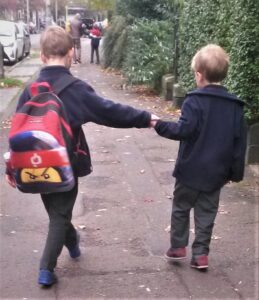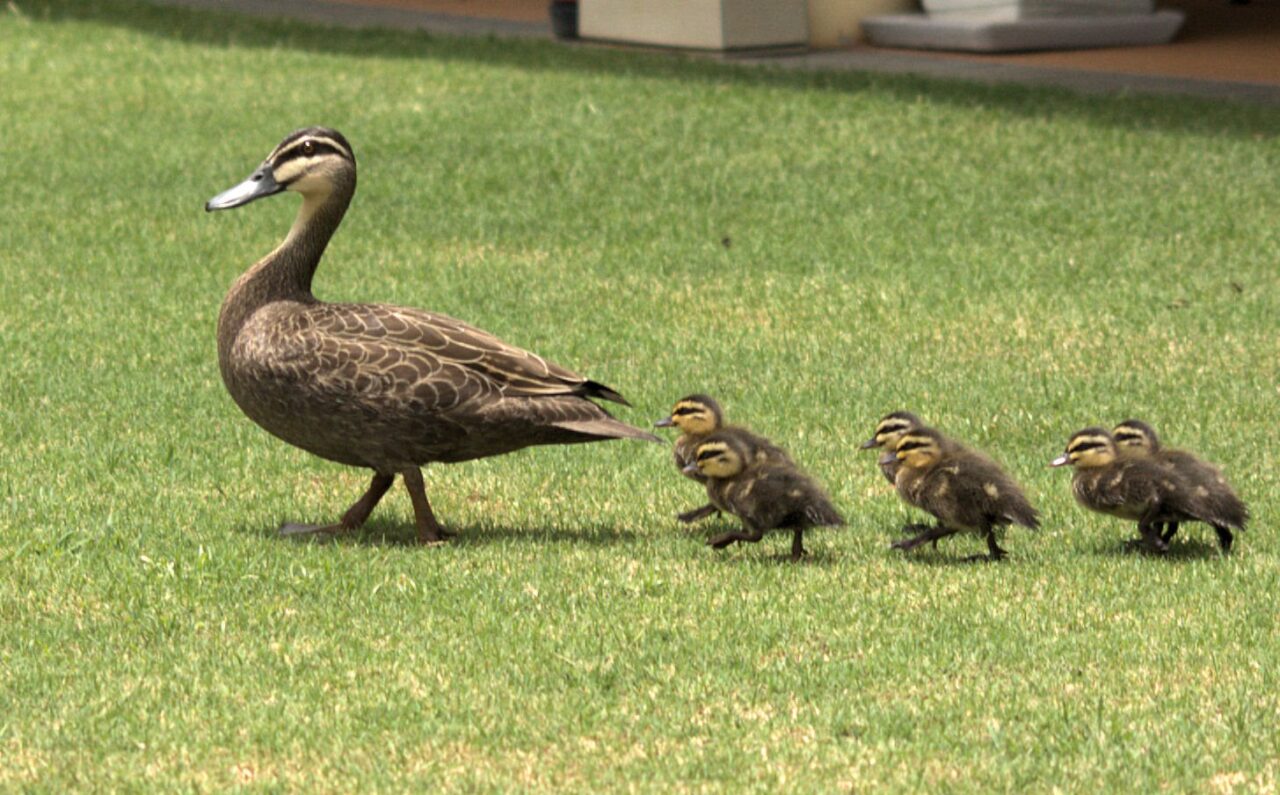I used to accompany my children on their walk to school. A common scenario, familiar to many. Some mornings were more fraught than others but I realised that this routine would not go on indefinitely (even if sometimes it felt like that). These ten or fifteen minutes are an important transition, from domestic persona as child, little brother, big brother to a participant in the institution of school. Class-member, pupil, pal to some, stranger to others. Adversary to one or two, no doubt, on occasion. Who else do they become during these hours away from home? Not really for me to know, I had to conclude.
Like all good rituals, our routine was highly symbolic. The habit of ‘taking to school’ was more than just that – really, we were escorting them out into the world.

You can share a lot in ten minutes.
Sometimes I tried to use the time to remind and cajole and encourage. This was never particularly effective. I think I got better at this parental duty when I realised that as soon as we’re on the way my role was very simple: Just be there. Look up when instructed and share the view (along a small, deliberate pointed finger). Walk with. Make space. Be a witness. In terms of conversation, less felt like more. Which is not to say there was no room for creative expression, humour, sometimes tears.
Musicians understand what it means to accompany someone, and what it means to be accompanied. They may not be able to tell you. In fact, words tend to get in the way. Some musicians are particularly known and valued for their skills as accompanists. Highly skillful musical accompaniment does rely on technical accomplishment, but it isn’t restricted to mastery of specific instruments; rather, it is a form of expressive, musical relating. “The sole differentiation between a solo and an accompaniment”, explained the late experimental musician and improviser, Cornelius Cardew (1972), “is in the mode of playing.”
In this relational sense, accompaniment is one way to understand what’s going on in many musical performance situations. The concept of accompaniment takes a particular meaning in certain musical traditions. For example, in the language of music education, the accompanist is often conceived as a pianist. For singer-songwriters, the guitar is often the companion. Yet framed in the broader, relational sense, accompaniment shows up as a familiar and functional role wherever groups of people make music together. Either pre-determined by compositional and stylistic norms, or agreed in the course of extemporised performance, the expressive prominence of musical material and voices (their foreground-ness or background-ness) is a variable common to musical situations spanning diverse formal, informal, everyday and artistic traditions.
In whatever way we attend to live music – a concert, a recital, a gig, a show, a session, or simply by being in or near the vicinity of a musical event – we come face to face with the material production of expressive utterance. The musicians’ efforts unfold before us: embodied, generative gestures motivated by lived experience and its attempted decoding through artistic communication. This expressive and intentional aspect is vital and evident. It’s also present in our encounters with mediated musical forms and sounds, in audio or audio-visual recordings, soundtracks to television, film or game, because how we hear this arises from the same crucible of human sound- and sense-making: Musical situations – however we come at them or they come at us – involve effortful relating.
Musical accompaniment is de facto inconspicuous. Cardew again: “An accompaniment is defined as music that allows a solo…to be appreciated as such”. Accompaniment is deliberately recessed from view. Its function is in fact to create prominence and form in some place other than itself. Therefore, the work of accompaniment is made manifest as context: it cannot be foreground. A melody – a tune – attains its prominence when we hear an expressive, coherent assemblage of contour, phrasing, and well-formedness. It’s a voice that we can relate to, perhaps sing back. Functionally, the accompaniment facilitates this expression through its alterity to the melody. It is a witness to ‘the solo’; the accompaniment creates the situation, shaping the solo utterance by generating and holding a responsive ‘space’.
What would happen if everyone had access to an education which prioritised skills in understanding and responding to the needs of other people? What would it take to systematically train people how to do this? Should we invest more in education that delivers this outcome? Does music education already do this? How could we do this better?
There is huge power in accompaniment, but it isn’t always easy to see. Even in imaginative terms, the contour of a melodic solo can lend itself to simple imagery; accompaniment, meanwhile, tends to be multidimensional, complex, subtle. And the process of accompaniment operates in a different domain to any eventual artistic product. It is creative, relational action. The intentions which motivate accompaniment, and the consequent actions which it motivates in turn, these processes occupy a different frame of experience – and invoke a different frame of reference – to the one in which the creative outcome itself can be perceived and understood.
Accompaniment, explained in this fashion, has some distinctive features:
- It is expressed as situated behaviour (it is both responsive and anticipatory)
- Its expression indicates tacit knowledge and expertise
- It is readily overlooked.
As a form of social interaction, accompaniment expresses relational intent, and has the potential to influence, to facilitate, and to generate change. Musical accompaniment, in this light, has huge potential to shape the creative outcomes of any collaborative, artistic performance. Translated to non-musical domains, the role of expert ‘accompanist’ maps to other spheres of social interaction. The anticipation of other people’s needs; a manner of operating which adapts to the contingency of these; labour and service which facilitates the very context in which another person can express their own utterance: these are the skills of the accompanist. Interestingly, they are skills that are most evident in traditionally female-dominated care professions, in nurturing roles, in education.
What would happen if everyone had access to an education which prioritised skills in understanding and responding to the needs of other people? What would it take to systematically train people how to do this? Should we invest more in education that delivers this outcome? Does music education already do this? How could we do this better?
(Paula M Wolter, Creative Commons Attribution-Share Alike 3.0 Unported)
(Image copyright Nikki Moran 2023. Do not reproduce.)
(Paula M Wolter, Creative Commons Attribution-Share Alike 3.0 Unported)



Leave a Reply